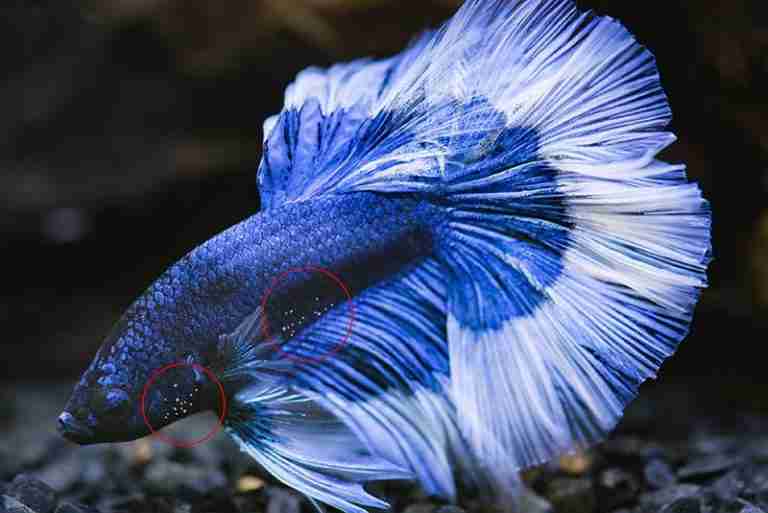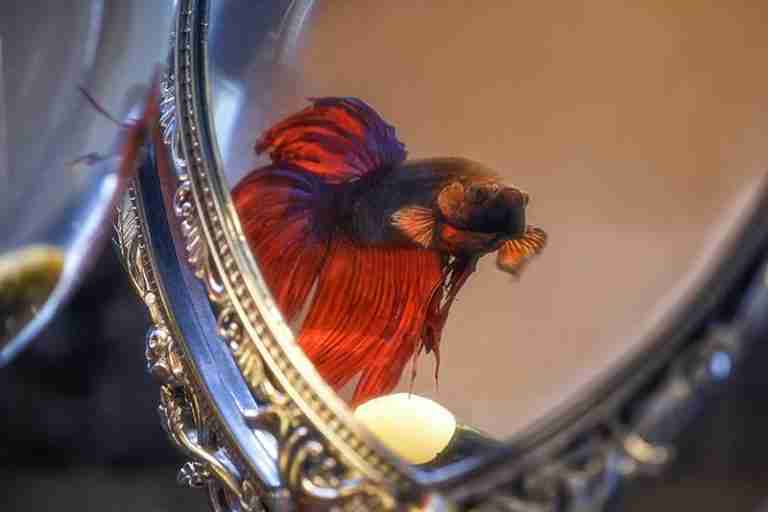What are Betta Stress Stripes and How to Get Rid of Them
A concerned betta owner recently asked me if I knew why their betta had suddenly developed stripes on its body. If you notice your betta has horizontal stripes that are not part of their natural color or pattern, and their onset is sudden, your betta is most likely stressed. So what are betta stress stripes?
Betta fish stress stripes are the sudden onset of horizontal lines running along your betta fish’s body, usually dark or black and more prominent on female betta fish. They are not to be confused with the similar-looking vertical stripes, which can indicate that your female betta is ready to breed.

It can be worrying when your betta fish suddenly develops stress stripes (also known as fear stripes, stress lines, and fear lines), and it is typically a sign that something is wrong but rarely something to get too concerned about unless there are other signs of ill health.
Don’t forget to read our Betta Fish Care Guide And Species Overview For Beginners.
What Do Betta Stress Stripes Look Like?
When betta stress stripes develop, they are the perfect way to identify that something is causing your betta to get stressed. Although stress stripes are not always present, they often appear on both sides of the body as thin, darkened, horizontal lines that run along your betta’s lateral line.
Betta stress lines are usually more prominent on female betta fish and often misinterpreted as breeding lines, but males can also get stress lines.
It is important to note that your betta can also be stressed without the presence of stress stripes, and you will have to rely on other signs and symptoms.
Female Betta Stress Stripes
As already mentioned, stress stripes on female bettas are more common and usually more prominent. The stripes can be darker than the surrounding color and are sometimes quite vibrant. Stress lines will be present on both sides and typically run horizontally along the entire length of the female betta’s body from head to tail. Often there will be 1 or 2 lines on each side.

Male Betta Stress Stripes
Male betta stress stripes are not always as prominent as the females, although similar in appearance (darker, more vibrant than the surrounding color, and often appear as 2 lines on each side). Usually, the male betta will become slightly paler in color, which will result in less obvious stress lines or none at all.
Betta Stress Stripes Or Breeding Stripes – What Is The Difference?
Stress stripes are easy to differentiate from breeding stripes. Stress stripes run vertically along the length of a male or female betta fish’s body, whereas female betta breeding stripes are much thicker and shorter than stress lines which are often only 1-2 millimeters thick.
Another big difference is that breeding stripes will only be found on female betta fish when they are in season.
There is no solid rule as both stress stripes, and breeding stripes can appear thicker or thinner depending on the fish, but they will always run in the correct direction.
The appearance of female betta breeding stripes shows that your female betta is ready and able to mate, and this is the perfect time to introduce them to a male betta.

When stress stripes appear on your betta fish, they are usually accompanied by other symptoms of stress or changes in fish behavior, and you will need to identify the cause of the stress before there are further problems with your betta’s health.
Below is a video I found that will better help you identify stress stripes.
What Causes Stress Stripes On Betta Fish?
Many factors can lead to a stressed betta fish which may cause stress stripes to appear. For example, sudden changes to your betta’s environment or the introduction of other fish that may be perceived as a threat can cause your betta fish to become stressed.
Below is a list of the most common factors that can lead to a stressed betta fish:
- Sudden changes to a bettas environment – New ornaments, new tank mates, and even large water changes, which can throw off the water parameters, can all lead to stress in betta fish.
- Introducing multiple male bettas together – Male bettas are prone to aggressive and territorial behavior, so keeping 2 or more together in a tank can lead to several stressed bettas and fear stripes developing.
- Keeping bettas in too small of an environment – Bettas are very active fish, so they require a lot of room to swim. If you have one male or female betta, the recommended betta tank size is a minimum of 5 gallons.
- Poor water quality – A dirty tank with high levels of ammonia, nitrates, and nitrites is enough to stress out any fish. Poor water conditions can also lead to water-borne diseases, and stress can lower a betta’s immunity making them more susceptible to water parasites and bacterial infections.
- Wrong water temperature – Bettas are tropical fish requiring warm water. Betta fish can live in temperatures outside of their preferred range for short periods but will not tolerate sudden changes to the temperature.
- Boredom – Betta fish are very intelligent and need adequate stimulation, or they will get bored and stressed.
- Illness – A sick betta will generally show signs of stress as they are less able to protect themselves from threats, and there will be general suffering from whatever infection they have picked up.
There are many more causes of stress in betta fish, and as you can see by the list above, it doesn’t always take much to set them off.
If you want to make your betta happy, you will need to pay attention and get to know their personality so that you will notice if something is not right with them.
Keeping your betta’s water clean is a must, and frequent water changes are one of the best ways to create a happy environment for your betta. These often solitary fish also like to feel safe, which means plenty of space to move and many hiding places. Betta fish love to hide when they want some quiet time, so try using some live plants and ornaments, which will be perfect for them.
A good diet is essential for a healthy and happy betta, and variety is vital when feeding them. Betta fish are carnivores and will eat worms, insects, and larvae in the wild, so ensuring that you occasionally provide them with live foods will do wonders for their stress levels.
I mentioned adding plants for somewhere to hide, and betta fish will also supplement their diet with some plant matter from time to time.
The best way to create an environment that your betta will enjoy is to mimic their natural habitat as closely as possible. If you want some tips you can read my article on setting up a betta tank.
Betta Stress Signs
Betta fish stress stripes are not always present, which is sometimes due to the early stages of stress. If you have noticed a few changes in your betta fish and think it may be due to stress, it will help remove the cause before it worsens.
Other betta stress signs are:-
- Frequent hiding – If your betta is spending a lot of time hiding and this is out of character, your betta may be stressed or unwell.
- Biting or scratching themselves against objects in their tank – This can happen when betta fish become stressed, but it could also indicate an illness such as Velvet Disease or white spot, which will need treatment.
- Frequently flaring or showing aggression – A male betta who can see his reflection in the tank glass can become aggressive and stressed. Try to establish what your betta is angry and flaring at, and it will probably be what’s causing your betta’s stress.
- Loss of appetite – A stressed betta fish will often go off their food, which is also a symptom of many other illnesses.
- Clamped fins – If you notice that your betta’s fins look tightly clamped together, this is often a good sign of stress.
Many people don’t consider stress a problem for fish, but it can be a massive problem and lead to much more severe illness.
Betta swim bladder disease is quite common and can be brought on by stress, among other things. Depending on its severity, swim bladder disease can be quite debilitating for your betta fish, and if stress is the cause, it is certainly worth trying to understand the cause of the stress.
By watching your betta’s body language, it should be easier to identify stress, enabling you to remove the cause much sooner and before it can become significantly worse.

When your betta fish is happy, you should notice them swimming around the tank more freely. It is a good sign when your betta shows more interaction with you and other tank mates.
On some occasions, you may even witness your betta building a bubble nest which is usually a sign that he is ready to breed, but it’s also a sign that your betta is comfortable and happy.
Can Betta Fish Die From Stress?
Betta fish can die from stress, but it’s not usually the direct cause. Stress is a leading cause of more severe illnesses. Consistently high-stress levels can severely impact a betta’s immune system leaving them open to illness caused by low levels of bacteria and parasites, normally considered harmless.
Keeping a betta fish in a stress-free environment can also help your betta to live longer.
How Do You Treat Betta Stress Stripes?
There is no specific treatment to get rid of stress lines on your betta except for removing whatever is causing the stress. It becomes more complicated when your betta is stressed because of illness. This is where you may need to consult a veterinarian or someone with several years of experience dealing with betta fish to identify the disease and establish a suitable course of treatment.
Once the stressing factor has been removed, or any illness has been successfully treated, you should see the stress lines begin to fade quite quickly, and your bettas natural color will return.
How Long Do Betta Stress Stripes Last?
Betta fish stress stripes can disappear as quickly as they appear or remain for several weeks or months. Once your betta’s stress level has decreased, the stripes will usually begin to fade immediately. However, it can depend on how sensitive your betta fish is to stress.
If your betta has developed stress stripes because they are uncomfortable in a new tank, adjusting can take some time. If your betta is sharing the tank with other fish, even if they are the most docile of fish, your betta may prefer to be on its own.
If stress lines are the only symptom present, you shouldn’t concern yourself too much as the level of stress is probably mild and will usually rectify itself over time.
Conclusion
I have discussed the potential causes of stress stripes in betta fish quite in-depth, which I hope has helped you to better understand the condition.
Stress stripes are unusual to look at when they suddenly appear, and they are not to be confused with breeding stripes which can appear just as suddenly. Stress stripes will usually develop horizontally and are often more prevalent in female bettas.
Anything that causes stress to your betta fish can cause these lines to appear, such as poor water conditions, incorrect water parameters, or a significant water change in the aquarium, which can throw off the parameters.
Even though bettas can be good community fish, sometimes a betta may prefer to be in a tank by itself. Just the presence of other fish may agitate them, especially male bettas, because their long plumage can be a prime target for fin nipping, leaving your betta feeling threatened and fearful hence why stress stripes are also called fear stripes.
Simply performing some regular aquarium maintenance such as cleaning and regular water changes and providing a healthy and balanced diet is often enough to keep stress levels at bay and will provide your betta with a comfortable, happy home.








